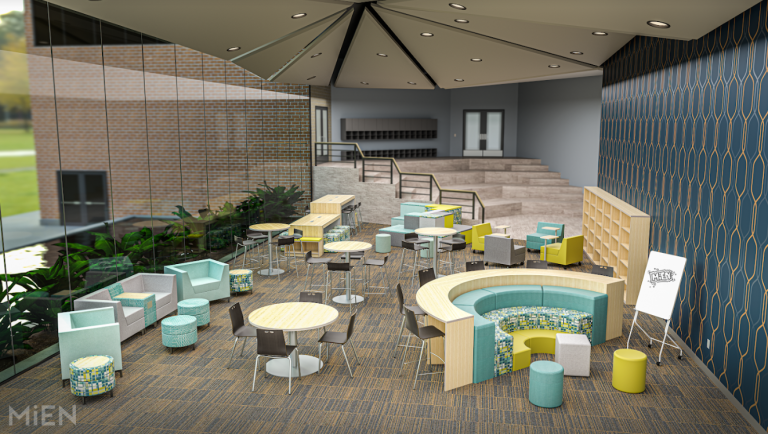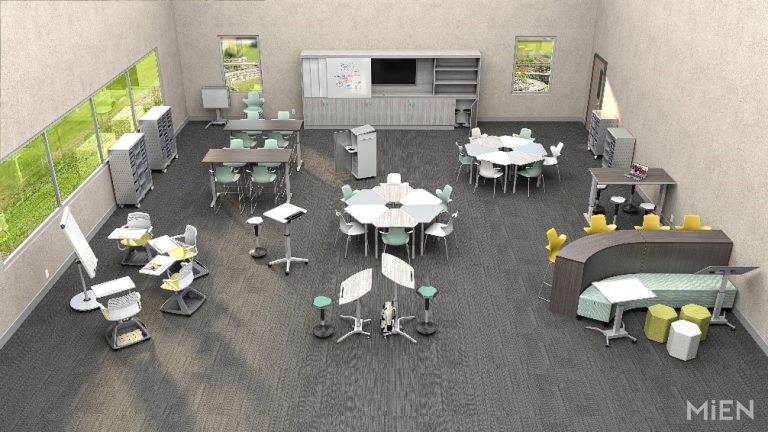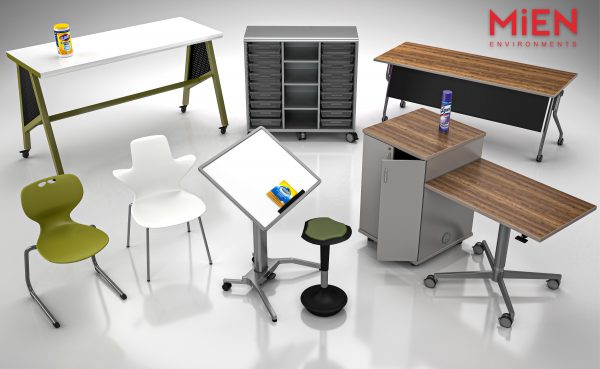(Sponsored content by Pigott)
The following article is reposted from Mien Company, a partner of Pigott, by author Dr. Christina Counts.
We are now in the midst of a new school year and American students, teachers, and staff are working through a new normal in classrooms to keep COVID-19 from a resurgence this fall. Many districts have considered what this may mean for their schools––face masks, social-distanced classroom layouts, and cancellation of large school gatherings and activities for the 2020-2021 school year.
One thing that is certain for schools has been the incorporation of greater cleaning and disinfecting procedures throughout classrooms, cafeterias, libraries, and school study spaces. Thorough cleaning and disinfection of work surfaces, school furniture, and other high-touch areas is key to ensuring continuous prevention of COVID-19 in schools and communities.
With this in mind, it’s important to consider how your school’s work surfaces and furniture materials will react to these increased cleaning measures—both in terms of successful disinfection and durability after repeated exposure to cleaning products.
What’s the Difference Between Cleaning and Disinfecting?
Although we may use the terms “cleaning” and “disinfecting” interchangeably in everyday conversation, they actually describe two different actions, both of which are equally important to maintaining healthy and safe facilities.
First in the process is cleaning, which is the action of physically removing germs and dirt from a surface. Cleaning a surface prepares it to be disinfected, which is part two in the process. Disinfection refers to the action of chemically killing and destroying viruses and bacteria on a surface. It’s crucial to use an EPA-registered disinfectant to effectively fight COVID-19 on surfaces.
Surfaces That Are Easy to Clean
It’s important to select certain work surfaces and seating options to fit your instructional goals, but now it’s also necessary to consider the health and safety implications of the finishes and materials you choose for the furniture in your school.

If your janitorial staff is going to be focusing their time on cleaning and disinfecting high-touch surfaces, it’s important that this task can be done quickly and effectively to ensure consistently sanitary and safe learning spaces. Here are some of the easiest surfaces to clean and disinfect:
Laminate
Similarly to vinyl, laminate work surfaces are simple to clean due to their non-porous surfaces, resistance to scratches and cracks, and absence of surface texture. Because laminate is a completely sealed surface, disinfection is also quick and effective, and can be done with a variety of EPA-registered disinfectants without degradation of the surface.
Formica has created a laminate cleaning guide that can be helpful in learning how to properly care for laminate work surfaces in your classrooms, including keeping them clean and free of germs.
Fabrics
- Vinyl

Vinyl surfaces are particularly easy to clean due to their non-porous surfaces and minimal texturing. A simple soap and water solution or other basic cleanser do a sufficient job at removing surface dirt and germs. Disinfection of vinyl should be done by following the directions of a compatible disinfectant––as long as the right products and methods are used, the vinyl material won’t degrade with repeated disinfection.
Stinson offers a disinfectant and cleaner compatibility tool in its online fabric browsing catalog, ensuring the compatibility of your school’s commonly used cleaning products with different vinyl and non-PVC materials.
- Performance Fabrics
Performance fabrics can still offer significant benefits when it comes to cleaning and disinfecting furniture in your learning spaces. These fabrics offer fun and vibrant patterns, and many are bleach-solution cleanable without staining or fading of the material. Some performance fabrics also contain antimicrobial additives, which halt the growth of bacteria, fungi, and dust mites in the material and increase the durability of the fabric and furniture.
MiEN fabric partners offer the ability to filter for bleach-solution cleanability when searching through fabric options in their online fabric catalogs. Stinson also offers a product filter for fabrics that are antimicrobial. Multiple filters can be selected simultaneously to find fabrics with the perfect combination of features for your school’s needs.
Durability and Making A Valuable Investment

With COVID-19 health and safety procedures expected to last in schools for a while, it’s important that the furniture you choose for your learning spaces is constructed with the right fabrics and finishes to withstand repetitive cleaning and disinfection. Not only are surface materials like vinyl, laminate, and performance fabrics known for their ease of maintenance and cleaning, but also for their strength and durability, even with consistent use.
Although school closures have had an immense impact on students and communities, an early end to in-classroom learning has created a unique opportunity to prepare safe and healthy learning spaces for students to use as they return to school this year. With the right combination of safe, easy-to-maintain surface materials and functional learning space design for your specific instructional goals, you can set your students up for success as they return to their classrooms.
To learn more about specifying high performance surface materials and MiEN products please visit www.miencompany.com.

Dr. Christina Counts, VP of Strategy and Development for MiEN Environments,is a proven leader with a successful background in transforming learning spaces to modern engaging learning environments. Dr. Counts has worked in education for over 17 years with experience as a classroom teacher, district instructional leader, school administrator, and digital and innovative learning designer. In her most recent position, Christina leads a team of professionals that support schools making the transition to a flexible, collaborative, & student-centered learning space. She holds a doctorate in K-12 Educational Leadership, National Board certified, and Google & Apple certified. Dr. Counts envisions a learning space in which educators are empowered to transform education through design, technology and innovative instructional pedagogy to create learners ready for any future!
Allison Dvorak, AIA, CPHC, is a member of the AIA South Dakota Board of Directors, liaison to the Emerging Professionals and Communication committees, and an architect in Sioux Falls. She received her M.Arch from North Dakota State University and continues to develop her Master’s thesis of researching and implementing design theories focused on human centered design through speaking engagements, design practice, and one-on-one client education. Allison lives in Sioux Falls with her husband, son and daughter.


